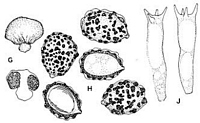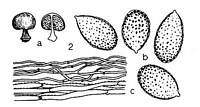|
 Cortinarius leucocephalus Cortinarius leucocephalus
SynonymsSecotium leucocephalum
Thaxterogaster leucocephalus
BiostatusPresent in region - Indigenous. Non endemic
Images (click to enlarge)
Caption: Thaxterogaster leucocephalus: G habit and section (Beaton 51) x 1; H spores x 1750;
J basidia x 1000. | 
Caption: Thaxterogaster leucocephalum (Massee) Singer &
Smith (type): a. fruitingbodies (sec. exsiccata), b. spores, c. cuticle. |
Article: Cunningham, G.H. (1924). A critical revision of the Australian and New Zealand species of the genus Secotium. Proceedings of the Linnean Society of New South Wales 49(2): 97-119.
Description: Peridium dingy-grey, depressed-globose, somewhat umbilicate, base truncate, excavated,
9-12 mm. high, 20-26 mm. wide, smooth, minutely longitudinally striate, glabrous, margin
tardily separating from the stipe; drying pallid brown, surface becoming rugulose. Stipe
whitish, slender, 12-25 mm. long, 3-4 mm: thick, attenuate downwards, solid, striate, smooth,
polished; columella expanded at the apex. Gleba ferruginous, cellular, cells laterally
compressed, up to 3 mm. long, dissepiments thin. Spores verruculose, pallid ferruginous,
ovate or ovate-elliptical, commonly lachrymiform, rounded at one end, pointed at the other,
9-11 x 5-7 µ (Massee, 8 x 5 µ), epispore thin.
Habitat: Habitat.-Solitary on sandy soil.
Notes: This species is characterised by the, small, smooth, depressed-globose peridium and long,
slender, solid stipe. The lachrymiform spores are also characteristic. The Mt. Lofty collection
is undoubtedly the same as the species described by Massee, as it agrees in all characters,
save in the size of the spores. The difference in spore measurement is too slight to allow of
the separation of these specimens. The solid stipe is a character present only in this and the
following species. In shape the plant shows a general resemblance to S. erythrocephalum, but
the pallid colour of the peridium, and the verruculose spores separate it.
I am indebted to Dr. Cleland for the loan of the material from which the above description has
been drawn up.
Article: Beaton, G.W.; Pegler, D.N.; Young, T.W.K. (1985). Gasteroid Basidiomycota of Victoria State, Australia. 3. Cortinariales. Kew Bulletin 40(1): 167–204.
Description: Gasterocarp 1.5-2.5 cm diam., almost globose
to depressed or turbinate, at times umbonate, basally depressed with or without
an exposed gleba, and borne on a short, bulbous stipe. Peridium off-white to
greyish white, drying pale greyish orange, smooth, glabrous, viscid to glutinous.
Gleba adnexed to adnate to the columella, light brown when fresh, drying dark
brown, consisting of small, angular, irregular chambers, up to 5 mm long, mostly
radially arranged to appear almost lamellate. Tramal plates thin, about 150
µm wide, white, with a broad, hyaline hymenophoral trama and narrow subhymenial
layers; clamp-connexions present on all hyphae. Columella percurrent, continuous
with stipe, expanding towards upper peridium, sometimes with short lateral branches,
white, translucent, up to 6 mm thick. Stipe 0.5-1 (-2.5) cm x 3-4 mm, cylindric
with a marginate-turbinate base, solid; surface white, smooth and glabrous.
Spore deposit dark brown. Spores statismosporic,
mostly heterotropic and asymmetric, 12.5-14.5 x 8-11(13.5 ± 0.5 x 9.5 ± 0.5)
µm, Q = 1.42, ovoid to broadly ellipsoid, yellowish brown, coarsely verrucose,
with verrucae often confluent to form short, irregular ridges, overlaid by a
loose myxosporium. Basidia 40-65 x 8-10 µm, cylindrico-clavate, bearing four
short, straight sterigmata. Hymenophoral trama regular, hyaline, of more or
less parallel, inflated, very thin-walled hyphae, 2-25 µm diam. Subhymenial
layer narrow, 10-15 µm, pseudoparenchymatous. Peridiopellis of variable, up
to 300 µm thick, forming an ixocutis of loosely woven, repent, thin-walled,
hyaline hyphae, 2-3.5 µm diam., embedded in a gelatinous matrix. (Figs 9 G-J,
17 E-J).
Notes: Although originally described from New Zealand,
Cunningham (1944: 85) reported this species from the Australian states of South
Australia and Victoria.
Article: Horak, E. (1973). Fungi Agaricini Novazelandiae I-V. Beihefte zur Nova Hedwigia 43: 200 p.
Description: To
the full description, given by Singer & Smith (1958), can be added only
a few additions. According to our observations on the type material (K) the
base of the stipe is not equal but obviously marginate (see Fig. 2 a) and attenuating
towards the apex.
Spores
12-14.5 x 8-9 µm ellipsoid, verrucose, warts coarser towards the apex, ferruginous,
± axially symmetric, perisporium well developed. Basidia and cystidia not seen.
Cuticle a cutis consisting of strongly gelatinised, hyaline hyphae (2-4 µm diam.),
hyphae of the subcutis cylindrical, encrusted with brown pigment, clamp connections
present.
Habitat: On
ground. New Zealand.
Notes: Singer & Smith (1958: 210) found that the description of Secotium leucocephalum given by Cunningham (1924: 112; 1942: 85) differs considerably from the details observed in the type material. There is no doubt that Cunningham based his description of this fungus on the type collection and on material from Australia which was supposed to be identical with the fungus from New Zealand.
The thorough study of this particular Australian collection revealed that their characters are significant enough to propose a new species: Thaxterogaster cunninghamii Hk. sp.n. (Differt a Th. leucocephalo (Massee) sporibus et habitu. Holotypus (PDD 8394)) - The spores measure about 9-11.5 x 5.5-6.5 µm, elliptic, warted, warts coarser towards the apex, rust brown coloured, perisporium not observed. The rooting stipe attenuates towards the base and shows no sign of a marginate bulb. - Examined material: Holotype (PDD 8394): 'Secotium leucocephalum Massee; Upper Waterfall Gully, S.A.; leg Cleland'. - PDD 8395: 'Secotium leucocephalum Massee; on dead wood, Mt. Lofty, S.A.; July 1928; leg Cleland'.
Fresh material of both fungi are needed to define exactly the macroscopical characters of the fruitingbodies. In spite of the little knowledge we have concerning the fresh carpophores of Th. leucocephalum (Massee) the nearest relatives are Th olorinum Hk. (1965: 218 (= Th. bibulum Singer 1969: 361) and Th. glutinopallens Hk. (1965: 220) in the Nothofagus forests of South America.
|